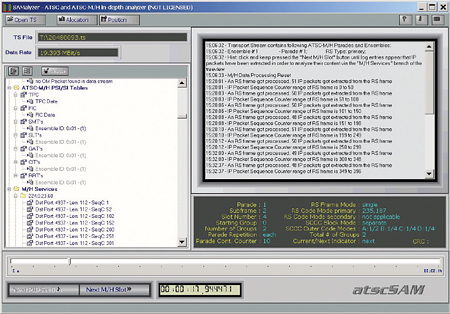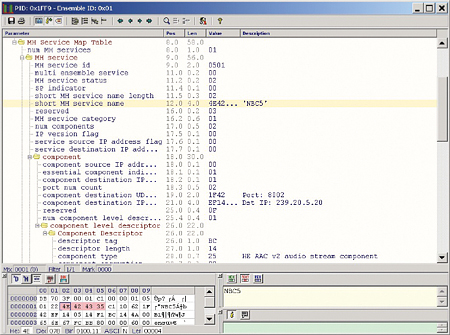Monitoring Signals with ATSC USB Tuners
LOS ANGELES: Since I started writing about Mobile DTV, readers have been asking “where can I get a receiver to monitor it?”
(From Doug Lung’s Most Excellent RF Technology column for TV Technology…)
About a month ago, in my weekly RF Report newsletter, I reported on software that allows ATSC Mobile DTV reception on most currently available off-the-shelf ATSC USB receivers. RF Report readershave tested the software on multiple receivers in multiple locations and verified that it works. I recently had a chance to evaluate both it and some additional software from the same company that allows detailed analysis of the ATSC signals--including A/153 data--with no special hardware.
TRANSPORT STREAM PACKETS
You may wonder how a conventional ATSC USB receiver can decode ATSC A/153 streams. The answer is that, to avoid breaking existing ATSC receivers, M/H data is encapsulated in special MPEG-2 transport stream packets designated as “M/H Encapsulation” (MHE) packets. (See my March 19, 2010 article “What to Look for in A153 Mobile DTV Tables.”)
As readers who have been following the development of the ATSC Mobile DTV standard know, the standard adds additional training signals to allow a Mobile DTV receiver to adjust its adaptive equalizer and lock onto the ATSC stream, even when the antenna is on a vehicle traveling through the urban landscape with rapidly changing multipath. A software-only solution will not be able to take advantage of the added training signals or other physical layer enhancements.
I’ve decoded A/153 Mobile DTV signals in multiple markets using the Mobile DTV Viewer from Decontis and various receivers, including the DVICO FusionHDTV7 USB tuner, the PCTV HD Stick Pro (Model 801e), and the Hauppauge HVR-950Q USB tuner.
RF Report reader and KTLA-TV Project Engineer Larry Price reported it worked with his old DVICO Fusion Gold 5 USB tuner and an ARTEC T14. It appears that any USB tuner that uses the Microsoft Broadcast Driver Architecture will work with the Decontis software.
Fig. 1 (left) is a screenshot showing the Mobile DTV Viewer and two “monitor” windows. The large one is the KXAS-TV main ATSC HD signal and the small one on the right is the KXAS-TV Mobile DTV signal. The program is the same on both monitors, but the extra processing for the Mobile DTV signal delays it by several seconds.
I have not tried using the Decontis Mobile DTV Viewer in a car, but after playing around with the antenna, the software-decoded mobile signal seems to be about as robust as the conventional ATSC signal—no better, no worse.
While the current version of the software does not take advantage of all the error correction available in the A/153 standard, Michael Hanel from Decontis told me, “The other embedded MDTV specific error-correction capabilities (PCCC-protected signaling information, FEC for both TPC and FIC, SCCC protected payload, RS frame FEC) can completely be performed in our software.” Look for additional enhancements in future versions.
Here are some tips for installing the software: To view both ATSC and ATSC Mobile DTV, you will need to let the program install VLC Version 1.10. The download option is available on the small monitor windows by clicking on the setup icon (the wrench) at the top of the window and “Setup.”
Other versions installed elsewhere on the computer won’t be used. If no video or audio appears after installing VLC, firewall software might be blocking it. Most firewall software will pop up a dialog box giving you the option of adding an exception for Decontis, or will add it automatically, but in case it doesn’t, check the advanced firewall settings and make sure that Decontis software is allowed to stream to the VLC player.
The current price for the viewer is $11.99--very reasonable, considering it’s a fast and easy way to scan all channels in a market, see which ones are transmitting Mobile DTV, and decode the mobile streams to see what they are transmitting.
The software will also display electronic service guide information. I wasn’t able to test it, however, as none of the stations I was able to monitor were transmitting anything more than a basic description of the channel.
Its ability to monitor multiple streams on the same channel could be useful in the master control of stations transmitting Mobile DTV, although one of the professional monitoring solutions from Decontis (atscSAM) or DTV Interactive (the ATA-1000) would provide the additional information needed to troubleshoot a problem.
SIGNAL ANALYSIS USING DECONTIS ATSCSAM
Michael Hanel was kind enough to loan me a demonstration version of the atscSAM software set. I was able to use Decontis’ SAMalyzer application to display tables from a recording of the KXAS-TV Mobile DTV stream I made using the Mobile DTV viewer.
Fig. 2 (right) is a screenshot showing the main window of the SAMalyzer. The box on the left has a tree view of both the ATSC and ATSC-M/H tables. The ones that are grayed out were not being transmitted. The M/H services are also displayed by IP address and port number.
You can scroll through the file and see exactly what packets were being transmitted. The upper right window displays the program status. The lower right window displays the mobile stream transmission parameters for the file being analyzed.
As far as I have been able to determine, the SAMalyzer only works with files. I was able to use it to view files I captured using record functions in the Rohde and Schwarz AEM-100 multiplexer, TSReader (recording the entire mux with all PIDs, including null packets), and, of course, the Decontis Mobile DTV Viewers.
Fig. 3 (left) is a screenshot of the level of detail the SAMalyzer provides for the SMT (service map table). As I pointed out in my March TV Technology article, if the descriptors are not correct in this table, some or all receivers will have trouble decoding the stream. At the bottom of the screen, you can see the data in the table (in hex notation) and in ASCII. The window in the lower right can be set to display the selected portion of the table in hex, text or ASCII.
There are other tools in the atscSAM suite to examine the ESG and FLUTE file transfers. For a more comprehensive solution that provides analysis and SNMP-based monitoring of all ATSC and ATSC Mobile DTV technical layers, Decontis sells the SAM-MT-450 monitoring probe. It can monitor up to eight multiplexes simultaneously. Full details are available at www.decontis.com.
I’ve encouraged Decontis to offer a very basic ATSC Mobile DTV monitoring/analysis software package at a price low enough that TV station engineers can verify their station is transmitting a proper A/153-compliant Mobile DTV signal and compare it to other stations in the market now while waiting for capital approval for more expensive test gear.
Decontis is the first company I’m aware of to offer ATSC Mobile DTV reception and stream analysis using conventional ATSC receivers. Now that they’ve shown it can be done, perhaps we’ll see some others.
ADDITIONS AND UPDATES
Last month I wrote about the use of distributed antenna systems to get digital TV signals into large buildings, malls and other RF shielded locations. In addition to American Tower Corp., I heard from Zinwave, which offers the Zinwave3000 wideband in-building wireless system. It works at frequencies from 150–2700 MHz. I hope to see how Mobile DTV works on DAS.
In previous columns I’ve used Los Angeles as an example of an area where on-channel repeaters would be needed for Mobile DTV reception in the urban canyons. When I had a chance to test Mobile DTV reception in downtown Los Angeles, I was surprised to see it wasn’t nearly as bad as predicted. The Mobile DTV signal survived where GPS didn’t.
Since the parts of the test area were completely surrounded by high-rise buildings, I can only assume that reflections from the buildings filled in the shadows--confusing GPS, but allowing Mobile DTV reception. Reception was more of a problem in the Staples Center area south of the skyscrapers where the mass of buildings becomes a more effective obstruction. I used a DTV Interactive AFT700/AFM500 and an LG prototype ATSC MH receiver for the testing.
Comments? Questions? E-mail me atdlung@transmitter.com.



Get the TV Tech Newsletter
The professional video industry's #1 source for news, trends and product and tech information. Sign up below.
